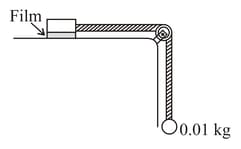Viscosity and Coefficient of Viscosity
Viscosity and Coefficient of Viscosity: Overview
This Topic covers sub-topics such as Coefficient of Viscosity, Poise, Poiseuille's Law, Viscous Force, Viscosity of Fluids, Dimensions of Viscosity, SI Unit of Coefficient of Viscosity, Relative Viscosity and, Strain Rate
Important Questions on Viscosity and Coefficient of Viscosity
What is the difference between viscosity and coefficient of viscosity?
What happens to the coefficient of viscosity if the temperature increases?
Water flows between two plates of which the upper one is stationary and the lower one is moving with a velocity . What fluid in contact with the upper plate?
For an extremely ductile metal the true fracture strain calculated from the reduction in the area of the specimen the and the elongation in the length of the sample will have different values.
The fluid that doesn't follow Newton's law of viscosity is called as_____.
What is the dimensional formula for the ratio of force to viscosity?
What would be the dimensional formula of viscosity if the dimensional formula of area is ?
Derive the dimensions of viscosity.
The dimensions of viscosity are
The fluid that doesn't follow Newton's law of viscosity is called as_____ fluid.
Name a substance which is a non-Newtonian fluid?
(Choose from: Blood/Water/Emulsion paint)
Name a substance which is Newtonian fluid from the following:
(Choose from: Blood/Honey/Water/Shampoo)
A metal block of Film area is connected to a mass is string that passes over a massless and frictionless pulley as shown figure. A liquid with a film thickness of is placed between the block and the table. When released the block moves to the right with a constant speed of . The coefficient of viscosity of the liquid is (Take )

Glycerine is filled in wide space between two large plane horizontal surfaces. A thin plate of area at a distance of from one of the surfaces is in horizontal position between the plates inside the glycerine. It is dragged horizontally at a constant speed of Take coefficient of viscosity . If the force required to drag the plate at constant speed is newton, find the value of

A small spherical drop falls from rest in a viscous liquid. Due to friction, heat is produced. The correct relation between the rate of production of heat and the radius of the spherical drop at terminal velocity will be
There is a 1 mm thick layer of water between a plate of area and another very big plate. The coefficient of viscosity of water is 0.01 poise. Then, the force required to move the smaller plate with a velocity of 10 cm/sec with respect to the larger plate is:
There is a thick layer of water between a plate of area and another very big plate. The coefficient of viscosity of water is poise. Then, the force required to move the smaller plate with a velocity of with respect to the larger plate is
Assertion: The coefficient of viscosity of a liquid is the viscous force acting on unit area of a liquid layers having unit velocity gradient perpendicular to the direction of flow.
Reason: Viscous force is directly proportional to area of liquid layer and velocity gradient.
Viscosity is closely related to -
A liquid whose coefficient of viscosity is flows on a horizontal surface. Let represent the vertical distance between two layers of liquid and represent the difference in the velocities of the two layers. Then the quantity has the same dimensions as -
